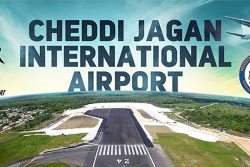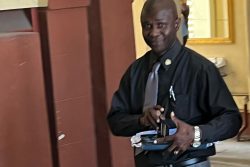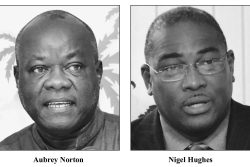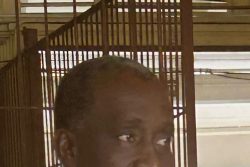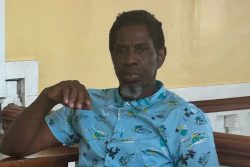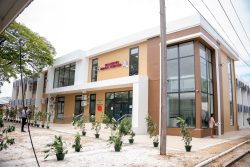The borders of Guyana, Venezuela and Brazil collide at the site of Mount Roraima, the tallest of the Pakaraima Mountains. It is nine miles long, 9,222 feet high at its tallest point with 1,300 foot cliffs on each side of the plateau. Its summit is largely sandstone with sparse vegetation and the isolated plateau is the unique home for species of flora not found anywhere else.
In November 1973, Scottish mountaineer, Hamish MacInnes led an expedition to the summit of Mount Roraima. The team was accompanied by a film crew from the British Broadcasting Corporation (BBC) which produced the splendid documentary ‘BBC Roraima Expedition to the Lost World’ which captured the extreme difficulty of the exercise. The climbers managed to conquer The Great Prow, a jutting pinnacle of rock, thus becoming the first team to attempt the sheer cliff from the Guyana side of the mountain. They spent a night strapped into hammocks on the sheer side of the edifice, the scary prospect of which was brilliantly captured in a photograph in MacInnes’ record of the mission, Climb to the Lost World.
Last week Thursday, Guyana’s Lost World was again back in the spotlight, as the World Wildlife Fund-Guianas (WWF-Guianas) launched a report of a Biodiversity Assessment Team (BAT) survey, the second of three parts. The field survey which took place between March 2nd and March 31st, 2014 in the Kaieteur Plateau and the Upper Potaro region “collected new data on terrestrial and freshwater taxonomic groups and also evaluated water quality to provide a comprehensive picture of biodiversity and habitats in the area,” according to an excerpt from the report.
The comprehensive 214 page report of the project provides an interesting insight into our distinct landscape, which, it noted, is 85 per cent covered by rainforest, the second largest proportion in the world, in terms of percentage of forest coverage relative to a country’s total land mass. It also highlighted the fact that at a time when the rest of the world is experiencing large-scale biodiversity loss and environmental degradation (read deforestation), ours remains virtually pristine, largely undocumented and poorly studied. The latter creates the difficulty of making efficient land-use planning decisions since there is a lack of data on which to go.
The highlight of the expedition was the discovery of thirty-one new or potentially new species, including three plant species, 15 aquatic beetles, five dragonfly species, two crustacean species and six fish species. At the time of preparing the report, the species were still being taxonomically finalized. The species were found within the environs of the Kaieteur National Park, in the vicinity of Kaieteur Falls, in the Upper Potaro Region, around the foot of Mount Ayanganna and in the Amerindian Village of Chenapau, home of the Patamona people.
The detailed report of the quest produced by WWF-Guianas in collaboration with Global Wildlife Conservation includes, Findings in Brief, maps of survey sites, chapters on the various forms of plant and animal life, and very detailed appendices. The Findings in Brief provides a quick overview of the trip and is filled with a lot of interesting details, such as the number of species of conservation concern recorded. The “Upper Potaro plateau is a broad transition zone between highland and lowland endemism on the Guiana Shield, but the elevational limits of many bird species are incompletely known, and published accounts of the region’s avifauna are few”, it states. This survey was the first inventory of crustaceans in the Kaieteur National Park; in addition to which eighty species of odonatan ‒ dragonflies and damselflies ‒ were documented; however, “542 separate ant collections are still in the process of being taxonomically identified to species level.”
The chapters entitled ‘Context: Ecological Importance of the Kaieteur Plateau and The Upper Potaro Region’, and ‘BAT Recommendations for Management and Conservation of the Kaieteur Plateau-Upper Potaro Region’ are must-reads for the stakeholders, namely, all Guyanese. The former notes that “…the Pakaraima Mountains – and thus our overall survey [are] part of the oldest rock formations on earth,” the biodiversity of the areas is among the richest of the Guianas and the wider Guiana Shield, and the Patamona Villages of Chenapau and Karisparu, which lie west of the KNP border have existed since the late 1800s.
The two chapters both highlight the danger of gold mining to the biodiversity of the areas, and the Amerindian way of life, especially the threat and potential dangers of mercury in the waterways of the region. The need to limit mining was heavily emphasized, along with the need to find alternative livelihoods for the Amerindians who depend on mining as part of their way of life.
We must acknowledge our gratitude to the WWF-Guianas, the field survey team and all the support teams, duly noted in the report, for their efforts in this expedition and its subsequent report which revealed new species and reminded us of our legacy.
The task of the Protected Areas Commission and other relevant government environmental agencies is an onerous one given the size of the area to be monitored and protected. We all have a role to play here, whether as curious visitors, or promoters of our country, responsible citizens or workers/ investors in the extractive industries, or residents, to acknowledge and respect our unique gift.
Our Lost World, our heritage, is one to be proud of and shared with the entire world.
